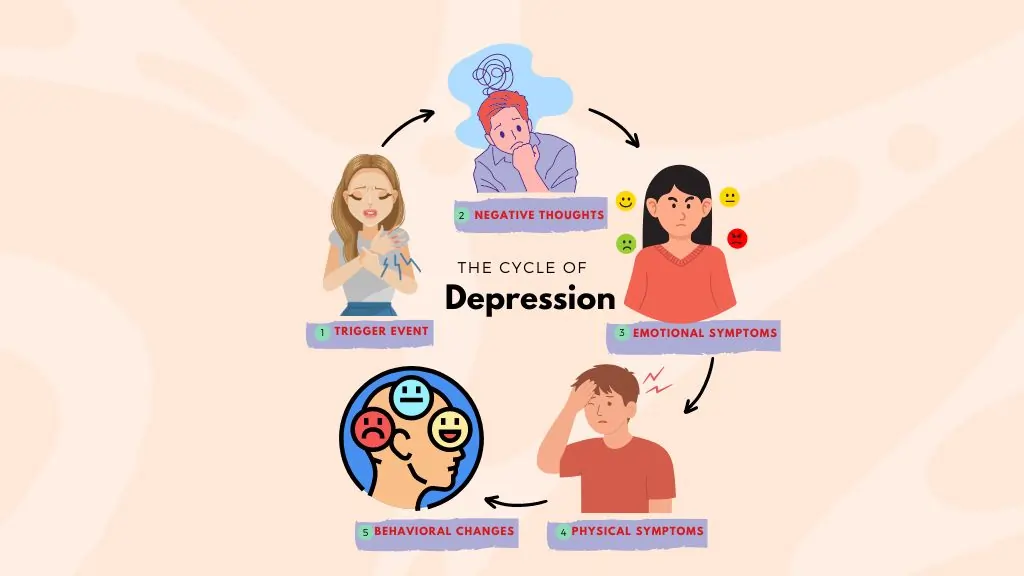Understanding the Cycle of Depression
Depression is a complex mental health condition that often follows a cyclical pattern, making it challenging to break free from its grip. Understanding the cycle of depression can help in identifying the signs and taking proactive steps to manage and overcome it.
The Cycle of Depression
The cycle of depression typically involves several stages that can feed into each other, creating a vicious loop. Here’s a look at the common stages:

- Trigger Event :- Depression often begins with a trigger event. This can be a stressful life event, such as the loss of a loved one, a relationship breakup, a job loss, or any significant change. Sometimes, the trigger might not be immediately obvious, and depression can arise seemingly out of nowhere.
- Negative Thoughts :-Said trigger event then leads to these negative thoughts taking root and having their way with the sufferer. Such thoughts can include hopelessness, low self-worth, and an excessive focus on guilt. The mindset is characterized by negative thinking that constantly reinforces pessimistic views regarding life in general.
- Emotional Symptoms :-As negative thoughts take hold, emotional symptoms of depression begin to emerge. These can include persistent sadness, irritability, anxiety, and feelings of emptiness. Emotional numbness and a loss of interest in activities once enjoyed are also common.
- Physical Symptoms :-If the thinking is negative, then the first symptoms of depression in the emotional aspect begin to show themselves. These are some of them, and they include a low mood that comes as a low mood that is always present, irritability, anxiety, and a feeling of emptiness, among others. These include no feeling of guilt if once guilty, or no feeling of sadness if once sad or depressed, or, in other words, being emotionally numb and having no desire to do what one used to enjoy.
- Behavioral Changes :-As a behavioral disorder, the symptoms of depression make patients emotionally and physically exhausted. Such behaviors might include social isolation, lack of productivity, inappropriate responses to situations that call for action, withdrawal from social settings, and decreased or limited performance. As it has been noted, this withdrawal can increase feelings of loneliness, hence leading to depression.
Breaking the Cycle of Depression
- Seek professional help :-Therapists, counselors, and psychiatrists can provide invaluable support. Cognitive-behavioral therapy (CBT) is particularly effective in challenging and changing negative thought patterns. Medication may also be prescribed to help manage symptoms.
- Develop healthy habits :- The availability of exercise for a normal activity, eating a balanced meal, and sleeping adequately influence mood and energy. Specifically, exercise helps in the secretion of endorphin, which in a way provides a remedy for the symptoms of depression.
- Practice mindfulness and meditation :- Mindfulness and meditation are the major techniques that can be very effective in minimizing the input of negative thoughts on an individual. Other relaxation methods include deep breathing, guided imagery, and progressive muscle relaxation to help manage stress and anxiety.
- Stay connected :- Maintaining social connections is crucial, even when you feel like withdrawing. Reach out to friends, family, or support groups. Talking about your feelings can provide relief and reduce feelings of isolation.
- Set small goals :- This way of working, that is, setting realistic goals, which can be divided into sub-step by sub-step, will help unlock one’s potential and bring about a sense of achievement. It is advisable to take small jobs as you progress step-by-step through the process to eventually accept higher-profile jobs.
Conclusion
Learning about the cycle of depression is the best way to start the process of ending that unwanted cycle. It is possible to manage and overcome depression if one is able to identify the stages and put measures in place to address those particular stages of depression. The fact that you are inquiring about help speaks volumes; getting the assistance you need will allow you to reclaim your own life and make positive changes.









